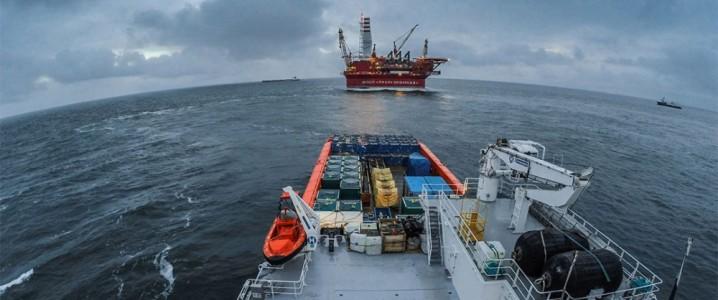Russia Delivers First Arctic
Oil To Key Ally China
Zero Hedge,
24 July, 2020
Ensuring a leading position in the exploration and development of the Arctic’s huge gas deposits has long been a key part of President Vladimir Putin’s overall vision to project the power of his new Russia. Not only has it allowed Russia to dramatically increase its liquefied natural gas (LNG) output – finally in line with Russia’s status as an oil and gas superpower, as Putin sees it – but it has also allowed Russia to become the key gas supplier to China in the future. With Russia’s presence in the Arctic gas sector now extremely substantial, it was only natural to expect a corollary roll-out of development of the oil sector, and this is precisely what is now underway.
Last week saw Russia’s Gazprom Neft, the country’s third biggest oil company by output and the oil arm of state gas giant Gazprom, ship its first cargo of oil produced in the Arctic to China via the Northern Sea Route (NSR). This shipment East adds to its existing Western exports via the NSR to Europe. According to Gazprom Neft, it took 47 days to deliver a full cargo of 144,000 tonnes of sweet, light Novy Port oil from the Yamal peninsula developments to the Chinese port of Yantai on the Bohai Sea, from Russia's north-western city of Murmansk. “Successful experience in the sale of Arctic oil in the European market and an in-depth insight of Asia-Pacific markets allow Gazprom Neft to offer Novy Port oil with a unique year-round logistics scheme to Asian partners,” said Gazprom Neft’s deputy director general for logistics, processing and sales, Anatoly Cherner, last week.
The NSR saw its first trial voyage (from the Far-Eastern Russian port of Vladivostok via the East Siberian and Laptev Seas, to St Petersburg) by a large-sized and strengthened container ship only as recently as August 2018. Since then, its development as a key transport route for Russian hydrocarbons to the East has run alongside the earlier developments of Russia’s number two gas producer (after Gazprom), Novatek, in its Yamal-centred LNG projects, that now uses it to deliver cargoes both East and West. After the very slick management at Novatek had delivered each stage of its Yamal Peninsular (Yamal LNG) project on budget and on time - despite the full weight of U.S. sanctions being imposed on Russia in 2014 as a result of its annexation of Crimea – until the delay to the fourth train announced last year, Gazprom and Gazprom Neft were bound to follow.
Much more is to come from Gazprom Neft, which started exporting oil produced in Russia’s Arctic exploration and development region in 2013, and which has delivered at least 40 million tons of oil – including both the ARCO (Prirazlomnoye field) and Novy Port (Novoportovskoye field) blends – to various European countries since then. In broad terms, the Novy Port oil field is one of the largest oil and gas condensate fields in the Russian Arctic, with at least 250 million tons (around 1.8 billion barrels) of reserves. Using a now proven system developed alongside Novatek – including the Prirazlomnaya oil production platform, the Arctic Gates oil terminal in the Gulf of Ob, a reinforced ice-class tanker fleet, including LNG vessels, escort icebreakers and an offshore oil shipment terminal in Murmansk - Gazprom Neft says that it can transport oil year-round (at minimal cost) to Europe.
To the East, there are more natural constraints, as very thick ice makes deliveries outside the summer period extremely difficult for much of the time, and the costs higher than those to Europe. Previously, the Novy Port oil grade shipped last week via the NSR to China - understood by OilPrice.com to have gone to state refiner, the China National Chemical Corporation (ChemChina) – had not been exported East by Russia, but rather directed towards Europe.
However, the enormous hit to the European refining sector caused demand to drop away, whilst demand in China dipped by a much degree and recovered fully much more quickly.
“Although Gazprom Neft has historically sent ESPO crude to China via the pipeline, this new capability will be useful to other Russian companies for oil as well, not just Novatek for LNG,” a senior oil and gas analyst in Moscow told OilPrice.com last week.
Russia’s number two oil company, Lukoil, also conducted a test crude oil delivery last September, featuring its Varandey blend. This has very similar specifications to the Novy Port blend, with the latter having an API gravity of 35 degrees and a 0.1 per cent sulphur content, whilst Varandey has an API gravity of 35-37 degrees and a sulphur content of around 0.5 per cent.
At the same time as opening up new export routes for its oil, Gazprom Neft is working towards dramatically increasing the oil volumes from the Arctic that it can offer to the East. In 2017, it acquired the development rights to the Tazovskoye and Severo-Samburgskoye fields in the Yamalo-Nenets region, with the subsoil usage rights to the Tazovskoye block running until 2025, and those to the Severo-Samburgskoye block until 2027. The Tazovskoye field is estimated to have recoverable oil reserves of at least 72 million tonnes, condensate reserves of 4.6 million tonnes, and non-associated gas reserves of at least 183.3 billion cubic metres. The Severo-Samburgksoye block’s estimated oil reserves are even higher, at 90.5 million tonnes. This followed the commissioning only a year before of the huge Novoportskoye oil and gas field (estimated recoverable reserves of more than 250 million tonnes of crude and condensate, as well as more than 320 billion cubic metres of gas) and the Vostochno-Messoyakhskoye oil and gas field (recoverable reserves of more than 470 million tonnes of oil and gas condensate, and 188 billion cubic metres of gas). 



No comments:
Post a Comment
Note: only a member of this blog may post a comment.